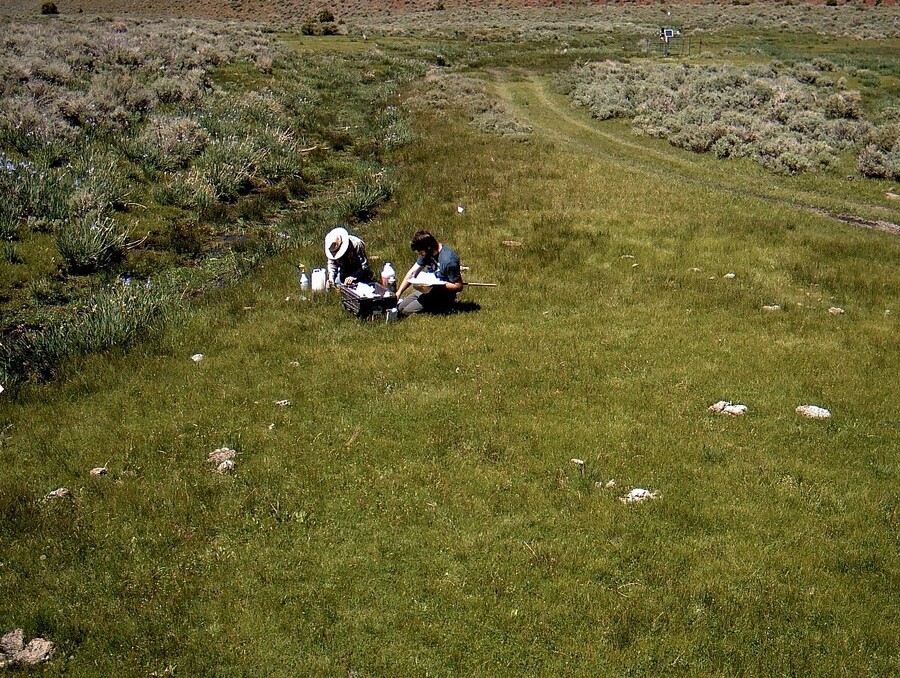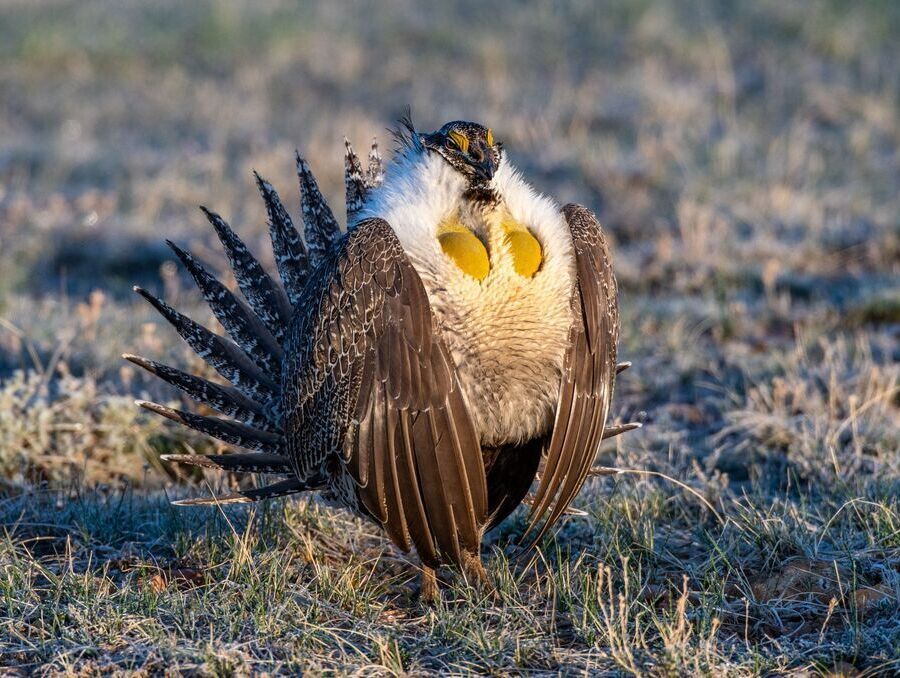A multi-agency study, spearheaded by researchers from the University of Nevada, Reno’s College of Agriculture, Biotechnology & Natural Resources and the U.S. Department of Agriculture, underscores the impacts of strategic cattle grazing, particularly on restoring the declining population of the greater sage-grouse bird, a keystone species in the Great Basin region.
Amidst ongoing decline, the U.S. Fish and Wildlife Service acted by listing the sage-grouse for protection under the Endangered Species Act in 2011. This move prompted the Bureau of Land Management to develop a federal conservation plan for the species in 2015. Simultaneously, the World Wildlife Fund classified the sage-grouse as “near-threatened” in 2014, signifying its concern about the species’ potential future extinction.
According to the study, the intensity and timing of grazing throughout the year has a significant impact on the availability of certain insects and plants that serve as vital food sources for the species, particularly during their reproductive phase. The insects, including beetles, moths, ants, grasshoppers and butterflies, are a key source of food for the species’ hatchlings in their first three weeks of life, while the flowering plants, known as forbs, provide nutritional benefits, especially for nesting birds.
“While many studies have explored various methods to restore greater sage-grouse populations, including restricting petroleum drilling in their habitats, our research specifically focused on enhancing the food supply within mountain meadow systems, which are key habitat for wildlife,” said William Richardson, the study’s lead researcher and a postdoctoral scholar in the College’s Department of Agriculture, Veterinary & Rangeland Science. "Protecting these birds, however, requires a holistic approach that ultimately extends to fostering the growth of insects, which serve as crucial food sources, pollination agents and more."
The sagebrush desert and shrubland are the predominant plant species in much of the Great Basin. However, a U.S. Geological Survey report indicates that nearly half of the region’s rangelands have been lost due to widespread habitat destruction, primarily from wildland fire. Native species such as the sage-grouse rely on this ecosystem for food and nesting and can survive nowhere else.
The study’s findings were first published in October 2021 in the Journal of Remote Sensing and later in December 2023 in the Journal of Environmental Management. The study, conducted between 2019 and 2021, assessed the impact of three grazing intensities on seven Great Basin meadows with varying vegetation cover in central Nevada. To monitor the proliferation of insects and plants on pastured meadows on a larger scale, the study employed the use of high-resolution digital cameras designed to capture time-lapse images of foliage over longer duration. They are commonly referred to as phenocams.
“These cameras allowed us to make real-time observations and collect data simultaneously over the study’s two-year period,” Richardson said. “They typically track plant lifecycles with high accuracy and offer a more practical way to make longitudinal observations in ecological research.”
At the end of the two-year observation period, data showed that an increase in grazing during the spring and summer had a significant impact on the vegetation communities in the meadow systems, with higher grazing intensities affecting the length of the growing season. This timing coincided with the breeding season of sage-grouse, during which the nesting birds depend on the flowering plants for food.
“This is an important finding as it emphasizes the sage-grouse’s high sensitivity to disturbance, especially when they are hatching and caring for their young ones,” Richardson said.
The study also found that grazing intensity was not ultimately detrimental to insect abundance, and even permitted some insects to thrive. Specifically, beetles were found in higher numbers when grazing occurred in both wet and relatively drier seasons, while the moths and butterflies showed an increase in population during the wetter seasons.

“Our results show that strategic grazing has the potential to have a positive impact on the biodiversity of meadow habitat, which not only benefits other species, but more so the sage-grouse, which is high up in the sagebrush food chain,” he said.
Other members of the research team include Professor Tamzen K. Stringham and Associate Professor Andrew Nuss from the College’s Department of Agriculture, Veterinary & Rangeland Sciences, Postdoctoral Scholar Brian Morra from the College’s Department of Natural Resources & Environmental Science and Keirith A. Snyder from the U.S. Department of Agriculture’s Great Basin Rangeland Research Unit. Stringham, Nuss and Morra also conduct research as part of the College’s Experiment Station. The team received funding and technical support from the Nevada Department of Wildlife, the U.S. Geological Survey and the Bureau of Land Management.
The shifting protection policies for the sage-grouse species
With sagebrush ecosystems as their only home, environmental experts have long considered the well-being of sage-grouse as a barometer for the overall health of the sagebrush ecosystems. In fact, according to the U.S. Department of Agriculture’s Natural Resources Conservation Service, a healthy sage-grouse population, restored through the restoration of its habitat, also supports 350 other sagebrush-dependent species, such as elk, deer, mule, pygmy rabbit and pronghorn, and nearly 200 migratory and resident bird species. Any decline in the species’ population, therefore, acts as a natural alarm for an imbalanced sagebrush ecosystem.
“The entire sage-grouse habitat is in the Western United States, and much of that land is publicly owned and managed by the federal government for purposes of conservation and development of natural resources, grazing and recreation,” said Brian Morra, a soil ecology postdoctoral scholar in the University’s Department of Natural Resources & Environmental Science, and a member of the research team. “Given this extensive federal involvement, research findings from publicly funded scientists, such as those presented in this study, play a crucial role in informing and supporting the habitat’s conservation policies.”
Despite numerous scientific appeals for the preservation of sagebrush-dependent species such as the sage-grouse and repeated warnings of their declining population from conservationists, federal support that mainly focuses on sage-grouse populations rather than the ecosystem health at large is an inconsistency that Morra cites as potentially detrimental to the long-term health of sage-grouse and the sagebrush ecosystems.
"It's disheartening to witness the challenges we face in achieving long-term sustainability for these ecosystems,” said Morra, whose research focuses on grazing management and soil health. “Regulatory support that considers ecosystem-level effects is crucial for advancing efforts towards preservation and ensuring a healthy future for generations to come."
The bi-state sage-grouse, a variety of the greater sage-grouse that is exclusive to Nevada and California, has had its own share of conservation drama. It is undergoing its third assessment in a decade for potential protection under the Endangered Species Act. With a dwindling population of approximately 3,300 birds, only half of its count 150 years ago, the bi-state sage-grouse continues to confront the same challenges, notably pinyon-juniper encroachment and decreasing viable habitat.
"The plight of the bi-state sage-grouse demonstrates the urgent need for comprehensive conservation action for the species," said Morra. “Scientific findings like this one must be amplified, and regulations need to be aligned with such findings to strike a balance between the needs of ecosystems and those of humans who use them.”
Funding for the project came from the Bureau of Land Management Carson City Nevada District; the Bureau of Land Management Nevada State Office; and the University of Nevada, Reno Great Basin Sagebrush Restoration Fund. Additional support was provided by the Bureau of Land Management through the Soil, Water and Riparian Monitoring and Research in Nevada, as well as the Nevada Forest and Rangeland Research Project: Desatoya Meadows sage-grouse habitat under the Great Basin Cooperative Ecosystem Studies Unit. The Nevada Department of Wildlife provided fencing installation for the study, and the U.S. Geological Survey helped in collecting sage-grouse data.















